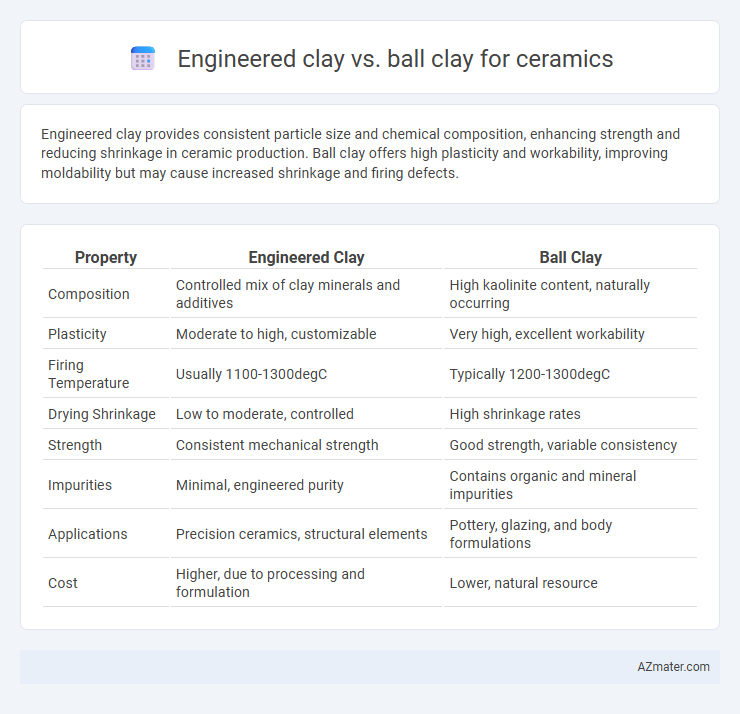Engineered clay provides consistent particle size and chemical composition, enhancing strength and reducing shrinkage in ceramic production. Ball clay offers high plasticity and workability, improving moldability but may cause increased shrinkage and firing defects.
Table of Comparison
| Property | Engineered Clay | Ball Clay |
|---|---|---|
| Composition | Controlled mix of clay minerals and additives | High kaolinite content, naturally occurring |
| Plasticity | Moderate to high, customizable | Very high, excellent workability |
| Firing Temperature | Usually 1100-1300degC | Typically 1200-1300degC |
| Drying Shrinkage | Low to moderate, controlled | High shrinkage rates |
| Strength | Consistent mechanical strength | Good strength, variable consistency |
| Impurities | Minimal, engineered purity | Contains organic and mineral impurities |
| Applications | Precision ceramics, structural elements | Pottery, glazing, and body formulations |
| Cost | Higher, due to processing and formulation | Lower, natural resource |
Introduction to Engineered Clay and Ball Clay
Engineered clay, a specially formulated ceramic material, offers controlled plasticity and consistent particle size, making it ideal for precise shaping and performance in ceramic production. Ball clay, composed primarily of kaolinite, mica, and quartz, is valued for its high plasticity and strength, essential for creating smooth, durable ceramic products. Understanding the distinct properties of engineered versus ball clay allows manufacturers to optimize the ceramic formulation for desired texture, fire resistance, and mechanical strength.
Composition Differences between Engineered and Ball Clay
Engineered clay contains precisely controlled proportions of kaolin, silica, and feldspar, resulting in consistent plasticity and strength tailored for ceramic production, whereas ball clay has a higher organic content and finer particle size, contributing to superior plasticity but increased variability. Engineered clay's mineralogy is optimized to reduce impurities, enhancing firing properties and reducing defects, in contrast to ball clay's naturally occurring deposits that often include variable amounts of mica and quartz. The compositional differences significantly impact the workability, drying shrinkage, and fired strength of ceramics made from these clays.
Physical Properties Comparison
Engineered clay offers controlled particle size distribution and improved plasticity compared to ball clay, enhancing workability in ceramic production. Ball clay exhibits higher fine particle content and greater plasticity, resulting in superior green strength but increased drying shrinkage and potential cracking. Engineered clay typically provides more consistent density and reduced impurities, optimizing fired ceramic strength and surface finish.
Workability and Plasticity in Ceramics
Engineered clay offers consistent workability with controlled particle size and minimal impurities, enhancing plasticity and reducing cracking during shaping. Ball clay provides superior plasticity due to its fine particle size and high organic content, allowing better moldability and flexibility in ceramic forming. For ceramics requiring precise shaping and uniform drying, engineered clay ensures predictable performance, while ball clay delivers exceptional plastic deformation characteristics.
Firing Temperature and Behavior
Engineered clay offers precise control over composition, resulting in consistent firing temperatures typically ranging from 1200degC to 1300degC, which enhances vitrification and strength in ceramics. Ball clay, with its high plasticity and fine particle size, fires at lower temperatures around 1000degC to 1150degC but may cause increased shrinkage and warping due to its organic content and particle size. Choosing between engineered and ball clay depends on the desired ceramic properties, firing temperature range, and shrinkage behavior for optimal kiln performance and finished product quality.
Impact on Final Ceramic Strength
Engineered clay offers precise particle size distribution and controlled mineral composition, resulting in enhanced mechanical strength and reduced porosity in ceramic products. Ball clay, characterized by its high plasticity and fine particle size, contributes to shape retention but can introduce higher impurities, potentially weakening the final ceramic strength. Selecting engineered clay over ball clay improves the durability and fracture resistance of ceramics due to optimized texture and minimal defect formation.
Color and Surface Finish Outcomes
Engineered clay offers consistent particle size and controlled mineral composition, resulting in more uniform color and smoother surface finishes for ceramics compared to ball clay. Ball clay, rich in kaolinite and organic matter, enhances plasticity but can lead to darker hues and varied surface textures due to impurities and variable particle size distribution. Selecting engineered clay optimizes color fidelity and surface smoothness, essential for precision ceramic applications.
Sustainability and Sourcing Considerations
Engineered clay offers greater sustainability benefits compared to ball clay due to its controlled mineral composition and reduced reliance on extensive mining operations, minimizing environmental impact. Ball clay extraction often involves energy-intensive quarrying and transportation, raising concerns about habitat disruption and carbon footprint. Sustainable sourcing prioritizes engineered clay for ceramics as it enables optimized raw material use and supports eco-friendly production practices.
Cost Analysis: Engineered Clay vs Ball Clay
Engineered clay generally incurs higher production costs due to its customized composition and processing requirements compared to ball clay, which is more abundant and easier to mine. Ball clay offers lower raw material expenses, making it the more cost-effective option for large-scale ceramic manufacturing. The choice between engineered and ball clay ultimately depends on balancing material performance needs against budget constraints in ceramic production.
Choosing the Right Clay for Your Ceramic Project
Engineered clay offers consistent particle size and composition, making it ideal for precision ceramic projects requiring uniformity and controlled firing outcomes. Ball clay provides excellent plasticity and workability due to its fine particles and high organic content, enhancing shaping and molding processes in ceramics. Choosing between engineered and ball clay depends on the project's need for consistency versus flexibility in forming and finishing stages.

Infographic: Engineered clay vs Ball clay for Ceramic
 azmater.com
azmater.com